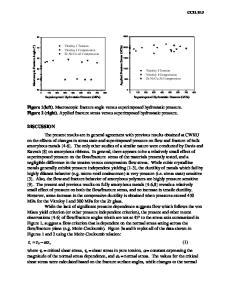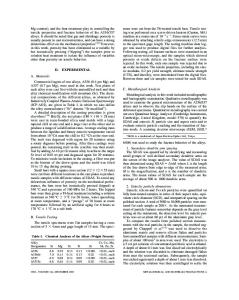Pressure effects on flow and fracture of Be-Al alloys
- PDF / 2,555,786 Bytes
- 10 Pages / 612 x 792 pts (letter) Page_size
- 103 Downloads / 306 Views
INTRODUCTION
MODERN aerospace structures demand high specificstiffness and strength materials. Beryllium is an attractive metal for its structural properties: it is lighter than aluminum (Al ⫽ 2.7 g/cm3 and Be ⫽ 1.85 g/cm3) yet stiffer than steel (Esteel ⫽ 206 GPa and EBe ⫽ 286 GPa). On the other hand, it reacts with numerous elements, notably oxygen, making its extraction and its processing rather difficult[1] and expensive. Also, beryllium has an unusually low Poisson’s ratio (v ⫽ 0.032), small lattice parameters (c ⫽ 0.358 nm, a ⫽ 0.228 nm, and c/a ⫽ 1.57), the lowest K/G ratio of all hexagonal close-packed metals (0.98, where K is the bulk modulus, and G is the shear modulus), and only a few independent slip systems (mostly (0001)/具1120典 and (1010)/具1120典) at room temperature. Its cleavage planes are the same as its principal slip planes (basal planes), and no slip system is resolvable in the “c” direction at room temperature.[2] These conditions contribute to the low ductility (i.e., less than 5 pct strain at fracture) often observed in its polycrystalline form at room temperature and atmospheric pressure (RTAP). Although oriented-beryllium single crystals can undergo large plastic deformation at room temperature,[3] polycrystalline Be generally exhibits low ductility at RTAP. In contrast, commercially pure aluminum (1100-O Al) is capable of deforming to high plastic strains at RTAP. Not heat treatable, it has a relatively low yield strength (y ⫽ 62 MPa), a low Young’s modulus (EAl ⫽ 76 GPa), and a relatively low strain-hardening rate. Aluminum has a high stacking-fault energy (200 mJ/m2) and more than the five slip systems required for high ductility in a polycrystalline metal. Partial dislocation recombination is easy, and frequent changes in dislocation slip planes are observed, producing high ductility. Alloying approaches have been used with Be to produce a material with a more balanced set of properties. Both JOE¨L LAROSE, Failure Analyst, is with Pratt & Whitney Canada, Longuevil, PQ, Canada J4G 1A1. JOHN J. LEWANDOWSKI, Leonard Case Professor of Engineering, is with the Department of Materials Science and Engineering, Case Western Reserve University, Cleveland, OH 44106. Contact e-mail:[email protected] Manuscript submitted October 12, 2001. METALLURGICAL AND MATERIALS TRANSACTIONS A
casting, as well as powder metallurgy techniques, have been used.[4–7] The limited mutual solubility of Al and Be[8] typically results in an interpenetrating network of two phases. The system studied in this article, AlBeMet 162, is composed of 62 wt pct Be and 38 wt pct Al (approximately 70 vol pct Be) and is produced via powder metallurgy techniques. The high volume fraction of the relatively brittle phase (i.e., Be) provides a structure (i.e., brittle/ductile) similar to some cermet systems. The flow and fracture of many monolithic materials under different stress states has been recently reviewed.[9] In particular, the early works of Bridgman and more recent works by others showed that yielding in most cubic and many
Data Loading...











